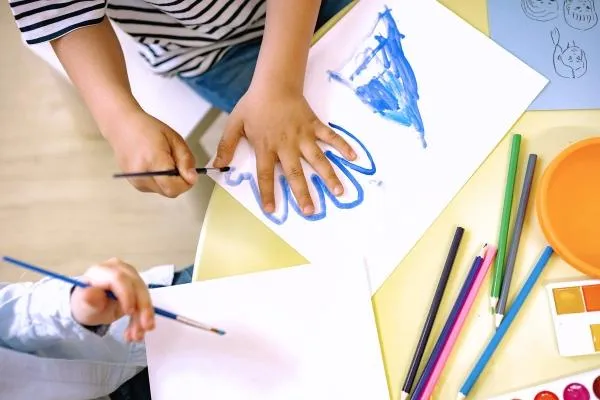
Unlocking the Power of Hands-On Learning: Engaging Young Minds with Interactive Resources
“Hands-on learning encourages children to explore concepts through direct experience, enhancing memory retention, problem solving skills, and fostering a love for learning through active participation”
Hands-on learning is a powerful way to inspire curiosity, foster creativity, and build foundational skills in young learners. Whether you're a teacher, parent, homeschooler, or daycare provider, incorporating interactive and tactile activities into your daily routines can transform the educational experience. At The Imagination Treehouse, we’re passionate about creating resources that support hands-on learning while making your life easier. Let’s explore how hands-on learning benefits children and how you can incorporate it into your lessons with our printable resources.

What is the Meaning of Hands-On Learning?
Hands-on learning—also called experiential or kinesthetic learning—is an educational approach where students actively engage in tasks and experiences to understand concepts. Rather than passively listening to instructions, students learn by doing. This could involve building models, conducting experiments, or manipulating objects to explore ideas.
Is Hands-On Learning the Same as Experiential Learning?
While hands-on and experiential learning share similarities, they are not identical. Both approaches involve active participation, but experiential learning focuses more broadly on reflecting on experiences to draw conclusions, often including real-world applications and problem-solving. Hands-on learning, on the other hand, emphasizes direct physical engagement with materials or tools to understand a specific concept. For example:
Hands-On Learning: Building a model of a solar system to understand planetary orbits.
Experiential Learning: Visiting a planetarium, discussing planetary movements, and journaling about the experience.
Why Hands-On Learning Matters
Hands-on learning encourages children to explore concepts through direct experience. Unlike passive forms of learning, such as listening to lectures or watching videos, hands-on learning engages multiple senses, which can:
Enhance memory retention.
Improve problem-solving skills.
Encourage collaboration and communication.
Foster a love for learning through active participation.
Scientific research supports these benefits. Studies show that the average retention rate of learning by lecture is 5%, while that of practice by doing (activity-oriented) is about 75%, demonstrating the effectiveness of hands-on learning in enhancing retention. Source
New Research Shows Learning Is More Effective When Active
Research from Carnegie Mellon University indicates that engaging students through interactive activities results in improved academic performance compared to traditional lectures, highlighting the benefits of active learning techniques. Source
What is an Example of a Hands-On Approach to Learning?
An example of hands-on learning is teaching children about plant growth by having them plant seeds, water them daily, and observe their development over time. This method engages their senses and curiosity while teaching key concepts about biology, responsibility, and patience.
Another example could be using a printable math game where students physically manipulate number cards to solve equations, combining learning with play.

Benefits of Hands-On Learning for Early Childhood and Elementary Education
1. Active Engagement
When kids use their hands to build, create, or manipulate objects, they’re fully immersed in the learning process. This type of engagement helps them stay focused and motivated.
2. Skill Development
Hands-on activities develop a range of skills, including:
Fine motor skills: Tracing, cutting, and coloring improve hand-eye coordination.
Cognitive skills: Activities like puzzles and counting exercises boost logical thinking.
Social skills: Group projects foster teamwork and communication.
3. Real-World Connections
Interactive activities help children connect academic concepts to real-world experiences. For example, using printable worksheets about weather patterns can deepen their understanding of the environment around them.
How to Teach Hands-On Learning
Incorporating hands-on learning into your teaching doesn’t have to be complicated. Here are practical steps to get started:
1. Identify Key Concepts
Determine the main learning objectives for your lesson. For example, if you’re teaching fractions, think about activities where students can physically divide objects, like slicing fruit or cutting paper shapes.
2. Use Engaging Materials
Gather tools and resources that support tactile learning, such as building blocks, craft supplies, or printable worksheets. Our collection includes tracing pages, cut-and-paste activities, and coloring sheets to make preparation easy.
3. Encourage Exploration
Allow students to experiment and discover. Instead of giving step-by-step instructions, ask open-ended questions that guide them to solve problems on their own.
4. Reflect on the Activity
Help students consolidate their learning by discussing what they did, what they learned, and how it relates to the lesson’s goals. This reflection ties into the experiential learning process, making the lesson even more impactful.
Tips for Parents and Homeschoolers
Parents and homeschoolers can easily adopt hands-on learning strategies at home with these tips:
1. Use Everyday Materials
Transform household items into learning tools. For example, use measuring cups to teach fractions or grocery items for sorting and counting activities.
2. Incorporate Play-Based Learning
Games and play are powerful tools for education. Try creating DIY board games that incorporate math problems or vocabulary challenges.
3. Create a Dedicated Learning Space
Designate a hands-on learning area stocked with craft supplies, science kits, and printable worksheets to encourage daily interactive activities.
Resources to Support Your Hands-On Learning Journey
At The Imagination Treehouse, we’ve designed a variety of resources to make hands-on learning accessible and enjoyable for everyone. Here are some popular options:
Printable Kids Activities: From connect-the-dots to themed scavenger hunts, our activities are perfect for keeping kids engaged.
Teacher Planners: Organize your lessons and plan interactive activities with ease.
Classroom Decor: Add an interactive component to classroom decor, bulletin boards and door decorations, like student name tags or themed crafts.
Free Resources: Don’t forget to explore our Free Resources Page for downloadable worksheets, decor, and more!
Start Building Engaging Learning Experiences Today
Hands-on learning doesn’t have to be complicated or time-consuming. With the right tools and a little creativity, you can provide meaningful, interactive experiences that inspire young minds. Explore our full collection of printable resources at The Imagination Treehouse and make every lesson an adventure in learning!
